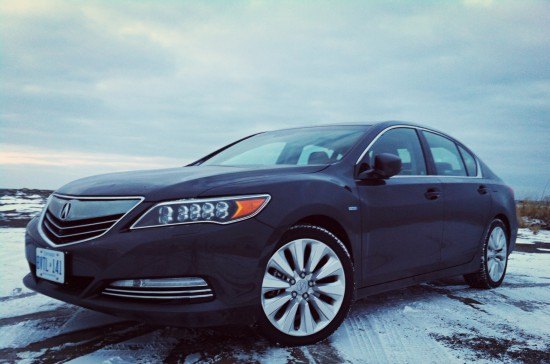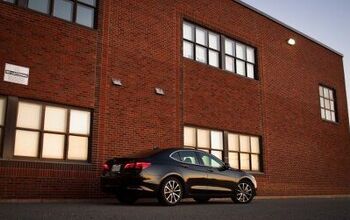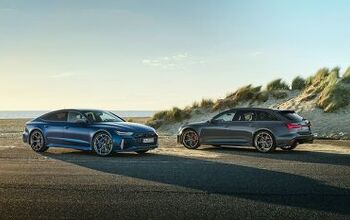Capsule Review: 2015 Acura RLX Sport Hybrid
Everything you see here is painfully normal. Much of what you can’t see is charmingly whimsical.
Turning the easily forgotten and forgettable Acura RLX into an RLX Sport Hybrid involves the employment of a cooperative seven-speed dual-clutch transmission, a front-mounted electric motor, and an unorthodox all-wheel-drive system that takes advantage of two more electric motors, one at each rear wheel.
• USD As-Tested Price: $66,870
• Total System Horsepower: 377 @ 6400 rpm
• Observed Fuel Economy: 21.8 mpg
It’s unlikely that you’re entranced by the RLX’s conservative exterior or in love with its dual-screen infotainment unit or in favour of the way it slowly engages reverse or thrilled with its shrunken trunk and cramped middle seating position.
But the RLX Sport Hybrid showcases Honda engineering prowess, and it does so in a way that’s not emulated by any other Honda product. The RLX Sport Hybrid doesn’t feature the new eight and nine-speed transmissions from the TLX, this is not a de-tuned 2016 NSX powertrain, and it’s not hiding the unique transmission-less hybrid kit fitted to the latest Accord Hybrid. This is a whole ‘nuther thing. This is Honda being Honda.
Unfortunately, the 2015 Acura RLX Sport Hybrid is not a big sports sedan, it’s not very good at serving big car duties, and it fell far short of our fuel economy expectations. The RLX Sport Hybrid is strangely fun, strangely disappointing, and strangely unpopular. Maybe the RLX Sport Hybrid is simply strange. In and of itself, I’m not sure that’s such a bad thing.
However, it’s clear that from a marketplace perspective, this just isn’t the way to do business. See, to make a point, we’re prone to saying things that don’t remotely correspond to reality: “There ain’t nobody buying Dodge Darts.” Well, actually, there are 7000 Dart buyers in America every month. In the case of the RLX lineup, the same statement lands much closer to the truth. Chronically unpopular, the RLX’s 32.5% year-over-year U.S. sales decline translated to fewer than 300 monthly sales in 2014. Those are Porsche Cayman-like numbers from a car which competes in a category where even mid-pack cars like the Audi A6 generate 2000 sales per month.
Of course, it could be argued that the RLX Sport Hybrid’s exclusivity adds a cool factor to the equation. It’s a rare version of a rejected car that observers won’t understand. (Or likely even notice.)
The rear electric motors add power to an already swift car and provide a form of four-wheel steering that causes the RLX to be tossed understeer-free into a corner with immediacy. All-wheel-drive cars which suffer from torque steer, like this Sport Hybrid, engender a measure of uneasiness in my RWD-loving soul – torque steer is for Saturn Ion Red Lines, not refined luxury sedans – and the sensation is worsened because the RLX isn’t a bastion of total traction in the snow. Nevertheless, with judicious use of heavy throttle, the RLX Sport Hybrid reveals itself to be a capable back-road burner, allowing a surprising degree of extra throttle application as it makes its way through a corner, feeling more and more like a much smaller car than it is.
Brake feel isn’t as predictable as you’d like, something we’ve come to expect in most hybrids. And in the RLX Sport Hybrid, the lifeless steering is the usual tell-tale sign that, regardless of its tricks, you are still driving a 4354-pound car. Yet viewed as a large car with sporting credentials, the RLX offers quite a bit of fun when called upon to do so, just not the level of aggression one would encounter in, for example, the latest Cadillac CTS Vsport.
From a refinement perspective, the RLX is disarmingly quiet but not as serene on rough roads as you assumed a heavy car with a 112-inch wheelbase would be. Perhaps the low-profile Michelin X-Ice (245/40R19) winter rubber is to blame for the marginal loss of tranquility.
Compared with the TLX we reviewed at Christmastime, there’s greater tranquility inside the car, as the heated seats are controlled by a conventional button just ahead of the different-for-the-sake-of-difference shifter. Rather than operating the frustrating screens – the lower one with fingers; the higher one with controls mounted below the lower screen – to call up basic controls, the RLX allowed me to turn on the cold car and press a button with no waiting period for a computer to come to life. Ah, winter’s pleasures.
Even the driver who forgives the RLX its modern Acura dashboard layout won’t enjoy the benefits of big-car living. At 196.1 inches long, the RLX is only five inches shorter than a Chevrolet Impala; it’s six inches longer than Acura’s own TLX. But the rear seat is built for two, as the centre floor hump is nearly as high as the seat cushion itself, and the middle seat cushion is perched up too high above the outboard positions for any kind of comfort. Window seat occupants are blessed with bountiful space, but the Sport Hybrid feels like a four-seater. The trunk, meanwhile, has been chopped down from the regular RLX’s decent 14.9 cubic feet to a tiny 11.6 cubic feet, 6% less than the capacity in the trunk of Acura’s small ILX sedan. Cross-country journey for five? No way. For four? Perhaps, but don’t pack too many extra pairs of underwear.
Of less importance to the well-heeled buyer of Acura’s most expensive current car (but surely of some interest to hybrid buyers?) was the disappointing mileage returned by our RLX Sport Hybrid tester over its week-long stay. The car, supplied to us by Honda Canada, is rated by the EPA at 28 mpg in the city and 32 on the highway. With bitterly cold weather, winter tires, and a mix of city/highway driving, we measured 21.8 mpg. Not bad for a genuinely quick car, but well below expectations.
With Acura’s disdain for actually designing its flagship sedan with some semblance of style being the worst of the RLX Sport Hybrid’s drawbacks, I progressively enjoyed driving the car more and more as the week wore on. But with supremely comfortable seats, 377 horsepower, keen turn-in inspired by the Integra Type-R, high equipment levels, and no questions from nosey neighbours who surely didn’t even notice the car parked in our driveway, why wouldn’t I?
Then again, I didn’t pay the USD $66,870 asking price, which is surely too much for a wallflower in a class full of attention grabbers. Acura needs to allow its designers to exercise their artistic talent the same way their R&D staff is permitted to concoct powertrain compositions. Marry the best of those two departments, especially if the car is truly capable of producing this much power with the stated fuel efficiency ratings, and they’d sell far more than a handful each month.
As it stands, there ain’t nobody buying this thing right now.
Timothy Cain is the founder of GoodCarBadCar.net, which obsesses over the free and frequent publication of U.S. and Canadian auto sales figures.
More by Timothy Cain
Latest Car Reviews
Read moreLatest Product Reviews
Read moreRecent Comments
- SCE to AUX Range only matters if you need more of it - just like towing capacity in trucks.I have a short-range EV and still manage to put 1000 miles/month on it, because the car is perfectly suited to my use case.There is no such thing as one-size-fits all with vehicles.
- Doug brockman There will be many many people living in apartments without dedicated charging facilities in future who will need personal vehicles to get to work and school and for whom mass transit will be an annoying inconvenience
- Jeff Self driving cars are not ready for prime time.
- Lichtronamo Watch as the non-us based automakers shift more production to Mexico in the future.
- 28-Cars-Later " Electrek recently dug around in Tesla’s online parts catalog and found that the windshield costs a whopping $1,900 to replace.To be fair, that’s around what a Mercedes S-Class or Rivian windshield costs, but the Tesla’s glass is unique because of its shape. It’s also worth noting that most insurance plans have glass replacement options that can make the repair a low- or zero-cost issue. "Now I understand why my insurance is so high despite no claims for years and about 7,500 annual miles between three cars.






































Comments
Join the conversation
This car sounds like a complete disaster. The packing is something even Ford would be embarrassed by. How do you get a sedan this big that is effectively a four seater that has a trunk smaller than many compact sedans? A Challenger, which is everyone's favorite punching bag for automotive obesity, is only 2" longer, 1.3" wider and about 100 lbs lighter (and that's with the scat pack). And why give design engineers the same freedom as powertrain engineers? The powertrain group gave you hybrid powertrain that only manages 21mpg. Acura's design team previously came up with the Acura beak. After that, it's no wonder they are on a tight leash. I'm not sure how anyone ends up with this in their driveway, cons1dering everything you could buy for $66k or less. A huge, heavy sedan that struggles carrying passengers and luggage fails at its primary purpose. It's no style statement either. And apparently with AWD and snow tires, it still isn't a "bastion of traction." This is not strangely unpopular; the only strange thing is anyone buys it.
This is really what Honda is and does when it comes to their high tech engineering. You can't see it but you can definitely feel it. The RLX sells well in Japan, especially to those that are enthusiastic about Honda engineering. I don't think Honda expects to sell the RLX in the US at large volumes. Americans don't want a 65K+ car that doesn't LOOK like a 65K car, regardless of its hidden tech. For those complaining about the RLX not having a V8- Honda is all about efficiency so manufacturing a V8 is completely unnecessary. Their V6 engines are good enough, but I'd love to see what Honda can do with a V8. In any case, Honda isn't a luxury car manufacturer and never was. If you talk to a Honda engineer, they'll remind you of that.